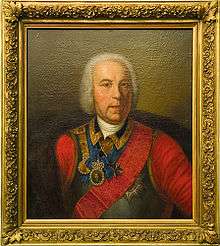Georg Wilhelm de Gennin
Georg Wilhelm de Gennin (Russian: Георг Вильгельм де Геннин) or Vilim Ivanovich de Gennin (Russian: Вилим Иванович де Геннин) (October 11, 1665 — April 12, 1750) was a German-born Russian military officer and engineer who specialized in mining, fortification, and metallurgy.[1][2]
Georg Wilhelm de Gennin | |
|---|---|
 | |
| Birth name | Georg Willhelm de Hennin |
| Born | October 11, 1665 |
| Died | April 12, 1750 (aged 84) |
| Allegiance | Russian Empire |
| Rank | Lieutenant General |
| Battles/wars | Great Northern War |
| Other work | Co-founder of Yekaterinburg and writer |
Biography
He was born as Georg Wilhelm Hennin on October 11, 1665 to a noble family, albeit one that was not of substantial means. The place of his birth has been of some contention with historians ranging speculation from Siegerland, then County of Nassau, Holy Roman Empire to Lower Saxony, or hailing from the Dutch Republic.[3][4] He was baptized in Siegen as Georg Wilhelm Henning in 1676. He later changed his name to Gennin, which is easier to pronounce for Russian speakers.[5]
During the Grand Embassy of Peter I in 1697 General Admiral Franz Lefort invited him to join the Russian Imperial army.[6][4] During the Great Northern War, Gennin excelled as an artillerist and fortification engineer.[7] In 1728, he was promoted Lieutenant General.
At first Gennin managed the iron foundries of Olonets and modernized the weapon factories of Povenetsky Uyezd, Koncheozersky, and Petrovsky.[2][5] He is considered one of the founders of Petrozavodsk. In 1722, he moved to the Ural, where he served for 12 years as a manager of Ural government factories.[8] Together with Vasily Tatischev, he was active in the foundation of the cities of Yekaterinburg and Perm.[5][9][10] While there he would dam the Iset River creating a power source for an iron factory the Czar had established, he would be involved in establishing several factories reliant on rivers throughout the area.[11][12]
Honors
In 1731 he was awarded an Order of Saint Alexander Nevsky.[7]
Culture
Gennin was the author of the book "Description of Ural and Siberian factories", where for the first time he gives the geographical and historical description of the Perm Krai, including the Yagoshikhinskiy, Pyskorskiy and Suksunstiy factories with drawings.[12] Gennin's sketches of Scythian era burial mounds in this work, these sketches would be utilized by other writers throughout the eighteenth and nineteenth centuries on the study of Scythian artifacts.[4]
In 2012 the German photographer Thomas Kellner traveled to Russia on behalf of RWE to work in Ekaterinburg and Perm to photograph industrial architecture (Genius Loci) as both cities were founded by Georg Wilhelm de Gennin. The factories he founded processed steel and metal. Kellner photographed not only on site in Russia, but also in the surrounding area of Siegen to capture the connection between the two regions in the processing of steel and metal.[13]
Today the city of Yekaterinburg preserves the memory of its two founders in a monument located along Lenina prospekt.[9]
Published works
- (in Russian) Г. В. Геннин. Описание Уральских и Сибирских заводов. 1735. — М.: Гос. изд-во «История заводов», 1937 (Description of the Urals and Siberian Smelteries)[12][14]
References
- Handy, Norman (2018-02-26). Crossing Russia on the Trans Siberian. novum pro Verlag. ISBN 978-3-99064-047-0.
- Solovʹev, Sergeĭ Mikhaĭlovich (1976). History of Russia. Academic International Press. ISBN 978-0-87569-066-7.
- Shandra, Andrey Valentinovich. "Штрихи к историческому портрету Г.В. де-Геннина". www.1723.ru. Ural State University. Retrieved 2020-08-15.
- Khudiakov, Y. S.; Borisenko, A. Y. "ARCHAEOLOGICAL MATERIALS OF THE SKYTHIAN TIME FROM G.V. DE GENNINA OF PRYRYTISHYA". web.archive.org. hist.asu.ru. Retrieved August 17, 2020.
- "Как всё-таки звали генерала Геннина?". www.1723.ru (in Russian). Вечерний Екатеринбург. November 18, 1998. Retrieved 2020-08-15.
- Manaïev, Gueorgui (February 12, 2020). "Pourquoi y avait-il de nombreux Allemands dans l'Empire russe?". fr.rbth.com (in French). Retrieved 2020-08-14.
- "ГЕННИН Де Вильгельм Георг (Georg Wilhelm de Hennin) - Уральская Историческая Энциклопедия". www.ural.ru (in Russian). Retrieved 2020-08-15.
- Анатольевич, Белобородов Сергей; Викторовна, Боровик Юлия (2013). "«Ревнители древлего благочестия» (очерк истории верхнетагильского старообрядчества)". Вестник Екатеринбургской духовной семинарии (1). ISSN 2224-5391.
- Haywood, A. J. (2010). Siberia: A Cultural History. Oxford University Press. ISBN 978-0-19-975418-2.
- "Estadio Ekaterimburgo Arena". abc (in Spanish). 2018-06-08. Retrieved 2020-08-14.
- Brumfield, William Craft (2020-06-12). Journeys through the Russian Empire: The Photographic Legacy of Sergey Prokudin-Gorsky. Duke University Press. ISBN 978-1-4780-0746-3.
- "HISTORICAL INFORMATION ON THE FOUNDATION OF PERM". archive.is. Permonline.ru. 2000-09-30. Retrieved 2020-08-18.
- "Kunst trifft Technik" [Art meets Technology]. RWE. 2014-11-24. Retrieved 2020-05-03.
- Whittaker, Cynthia H.; Kasinec, E.; Davis, Robert H. (2003). Russia Engages the World, 1453-1825. Harvard University Press. ISBN 978-0-674-01278-3.
- (in Russian) Энциклопедия Пермской области - ГЕННИН.
| Wikimedia Commons has media related to Georg Wilhelm de Gennin. |